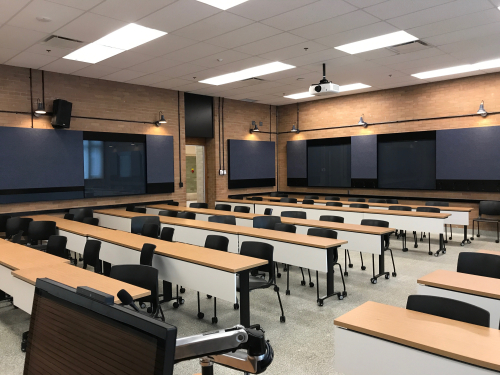- Location: 815 Sherbrooke St. West, Montreal, QC
- Capacity: 84 students per room
- Type: Flat classroom
Alignment with principles for designing Teaching and Learning Spaces
Academic challenge
Promote individual, active engagement with content.
Layout
Work surfaces for notebooks, laptops, and textbooks.
Acoustics: Acoustic design to avoid distraction from outside and inside sources.
Furniture
Comfortable chairs on wheels permit students to work individually or in groups.
Technologies
Access to resources: LMS, internet (via student laptops).
Lighting & colour
Appropriate lighting for individual work. “The Blueprint”, the Faculty of Engineering’s code of ethics, is displayed prominently on the back wall, to give students a sense of place.

Learning with peers
Promote active engagement with one another.
Layout
Flexible layout permits students to move easily from small group (groups of 2-4 students) to larger group activities.
Acoustics: Sound zones support multiple simultaneous conversations among students.
Furniture
Chairs on wheels permit students to easily turn to discuss and work with those next to or behind them. Lightweight chairs and flip-top tables allow for easy reconfiguration of the classroom to support a variety of collaborative learning approaches.
Technologies
Glass writable boards wrap the room, providing ample shared workspace for student brainstorming, work on projects, and presenting.
Lighting & colour
Large frosted windowpanes bring in diffuse light.

Experiences with faculty
Promote interaction and communication.
Layout
Instructor is not limited to the “front of the room” and instead has access to all students due to easily mobile furniture.
Acoustics: Sound zones ensure that not only are students able to hear the instructor, but that the instructor is also able to hear the students. Wired and wireless instructor microphones are available.
Furniture
The podium provides ample space for all instructional materials, and has a height adjustment for accessibility and convenience. Mobile furniture for students supports different teaching strategies.
Technologies
Classroom technologies (data projector, document camera, sympodium, wireless screen sharing) permit display of different learning materials.
Lighting & colour
The combination of black-backed and white-backed glass writable walls provides contrast within the room.

Contributions to the campus environment
Classrooms that incorporate elements of active and collaborative learning are part of a vision for a variety of flexible campus learning spaces. This classroom is designed for all populations using the space: well-lit, with a standardized room control panel that simplifies instructors’ use of equipment in classrooms across campus. IT is consistent with teaching and learning needs, and durable furniture contributes to sustainability efforts. Both physical and virtual affordances help maximize High Impact Practices (HIPs) for student learning within and beyond this classroom.
